
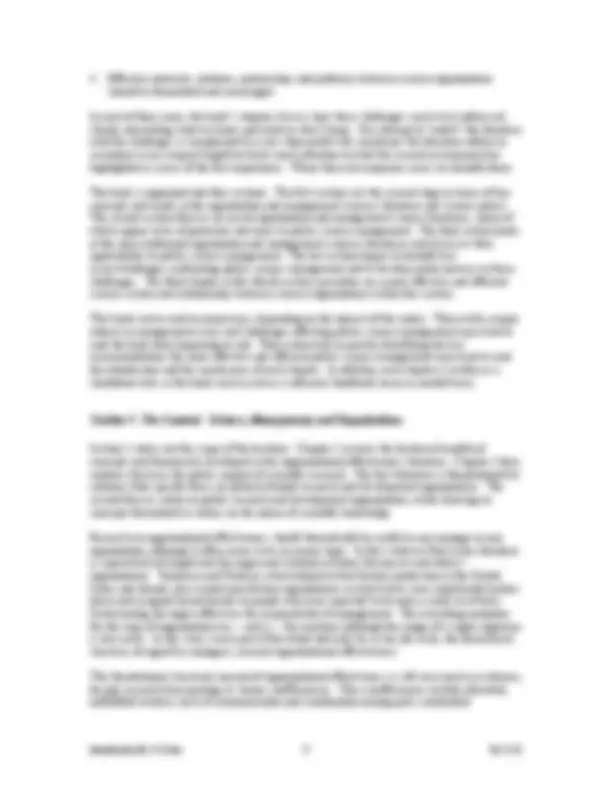
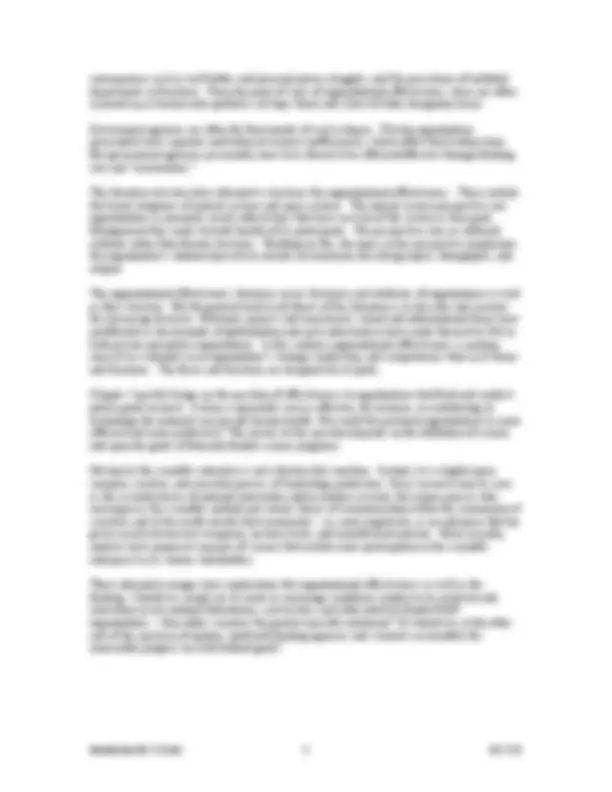
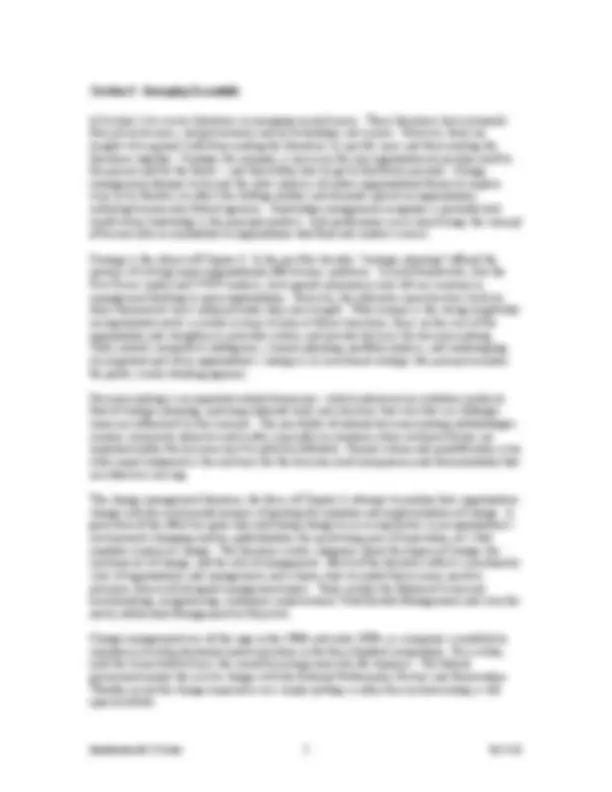
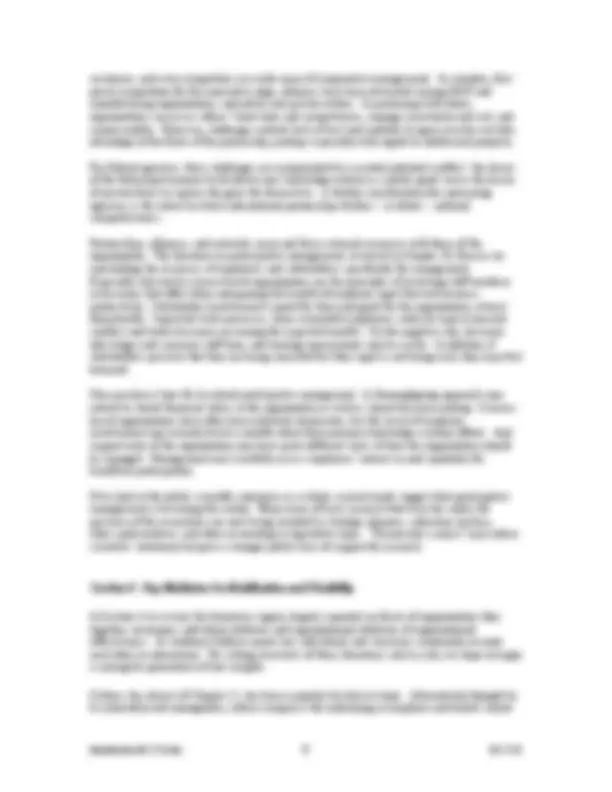
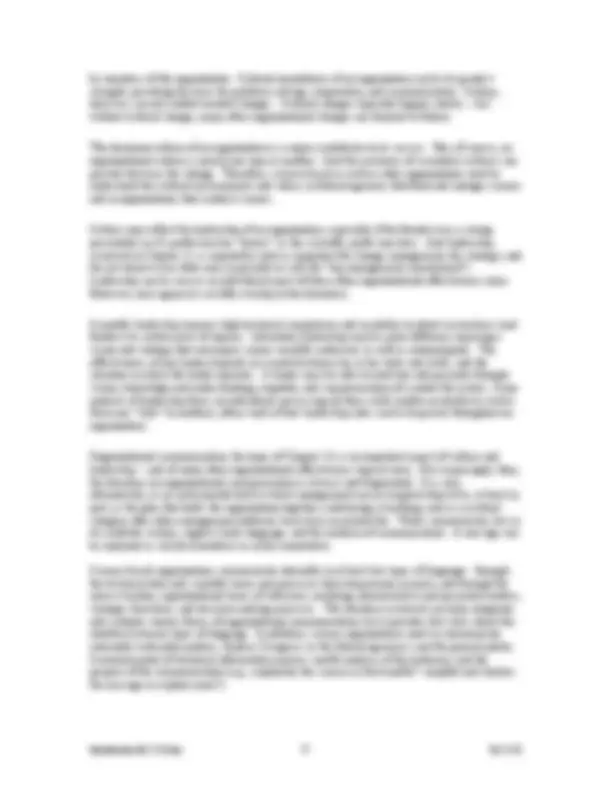



Study with the several resources on Docsity

Earn points by helping other students or get them with a premium plan


Prepare for your exams
Study with the several resources on Docsity

Earn points to download
Earn points by helping other students or get them with a premium plan
Community
Ask the community for help and clear up your study doubts
Discover the best universities in your country according to Docsity users
Free resources
Download our free guides on studying techniques, anxiety management strategies, and thesis advice from Docsity tutors
Management Benchmark Study-Book Summary Introduction-Literature-Elizabeth L. Malone Managing Science, Elizabeth L. Malone, Design, Key Attributes for Mobilization and Flexibility, Drawing on the Organizational Sciences Literatures
Typology: Summaries
1 / 11

This page cannot be seen from the preview
Don't miss anything!







This is a good time to be studying the management of public sector science organizations, both those that fund and direct science; and the laboratories, universities, and other research organizations that conduct scientific research. The goals, processes, and outcomes of publicly sponsored research are under increasing scrutiny. Expectations of the benefits science can provide are escalating at the same time that fears and concerns about adequately controlling the power of science are also on the rise. Disruptive change in the external environment of public science – globalization, telecommunications and information technologies, the emphasis on commercialization and intellectual property protection, and changing geopolitical alignments and priorities – is requiring managers of public science to rethink or adapt their goals, strategy, organizational design, partnerships, work processes, and technologies. Some, like those in the Office of Science at the Department of Energy, have experienced a blurring of their mission following the end of the Cold War. The Department of Energy and other federal science agencies have increased their national and international partnerships to tackle “big science.” All U.S. science agencies are adjusting to the dramatic breakthroughs in the life sciences and the relative decline in funding for the physical sciences, the fundamental shift in industry and universities from long-term R&D, the mandate for performance-based management, and the use of information technologies to create virtual teams and labs without boundaries.
Managers of public science are stewards of the public good and of essential national capabilities. At the same time, they are expected to employ effective management practices and to understand and reflect the new insights and perspectives emerging from the management and organization sciences. This is a challenge. Managers in science organizations tend to think of themselves as scientists first and managers second. Consequently, they are more inclined to read and think about science than about organizations and management.
But even if these science managers sought out the new research in the organization and management sciences, they would find few guideposts to information that has been shown to be applicable to them. The management and organizational sciences have historically focused much more intensively on private sector business organizations than on public science. Differences between science organizations and business enterprises thus make it necessary to interpret how research based on business enterprises applies to public science.
Key differences that mandate this interpretation include the public-good nature of science contrasted with the profit motivation of business; the long-term, diffuse outcomes of science versus the short-term, targeted growth of business; and the focus on complexity and knowledge- creation of science instead of the product orientation of business. Public sector science organizations may have a goal of efficient management, but they do not have a profit, bottom-line motivation. Their principal purpose is not to make money but to improve social well-being. Consequently, their most important outcomes are not intended to be captured on a business balance sheet, but rather to become evident over time in improvements in education and knowledge, the quality and quantity of work available to workers, national security, quality of life, and so on.
Despite these well-known differences, the management models used by public sector science organizations are modeled on private sector, non-science organizations. A review of the classical
organizational models makes this clear. So, although science managers may find valid descriptions of models that currently exist in their organizations, they will also find that the rationales and evaluative methods for these models are more relevant to for-profit firms than for publicly funded science organizations.
Nevertheless, the adamant view that business-oriented literature is irrelevant to the management of publicly funded basic research is increasingly being questioned. Recent developments, such as government-industry partnerships to conduct R&D, a greater focus in the public sector on performance-based management and an enterprise model of scientific research, and growing attention by businesses to their contributions to the public good, are blurring the distinctions between public and private, science and business. As a consequence, the organizational and management sciences are becoming more applicable to public science organizations, despite their continued focus on private sector organizations.
This book explores the manager’s role in promoting and facilitating beneficial and efficient management of public sector science. It differs from most books on public science in that it investigates the practical side of funding, directing, and managing science rather than focusing on science policy. Most recent books on public science deal primarily with the issue of the government’s responsibility for promoting and facilitating science. This book identifies and reviews relevant literatures -- whether directed at the public or private sector, or at science or non-science organizations -- to advance our understanding of public science management. The primary purpose of this book is to help managers of public science improve their practical ability to effectively fund, direct, and manage science by examining the literature for insights on how to improve (a) internal management practices of the various types of public science organizations; (b) the relationships among science organizations at all levels; and (c) the functioning of the science system as a whole.
All who are involved in management of research in federal agencies and in laboratories, universities, and other research organizations can learn from this book. These include ♦ Managers and change agents in public sector science funding, facilitating, and oversight organizations ♦ Managers and change advocates in public and private science research organizations ♦ Academics interested in public and private science organizations and science policy ♦ Science policy decision-makers.
The broad mission of public scientific management is to create knowledge, particularly knowledge about the fundamental processes of the universe. Directing and managing toward that mission requires a unique set of understandings and skills. For managers in public sector organizations that fund basic research and in the universities and national laboratories conducting that research, this book identifies and addresses the critical challenges posed by the enterprise model of scientific research, and recent and ongoing changes:
consequences such as turf battles and personal power struggles; and the persistence of outdated departments or functions. From the point of view of organizational effectiveness, these are often summed up as bureaucratic gridlock, red tape, bloat, and a host of other derogatory terms.
Government agencies are often the focal points of such critiques. Private organizations presumably have a greater motivation to remove inefficiencies, which affect their bottom lines. But government agencies presumably have to be forced to be efficient/effective through funding cuts and “reinventions.”
The literature also describes alternative structures for organizational effectiveness. These include the broad categories of natural systems and open systems. The natural system perspective sees organizations as primarily social collectivities that have survival of the system as their goal. Management thus needs to build loyalty of its participants. The perspective stresses informal relations rather than formal structures. Building on this, the open system perspective emphasizes the organization’s relationship with its outside environment, describing inputs, throughputs, and outputs.
The organizational effectiveness literature covers functions and attributes of organizations as well as their structure. But the general trend in all facets of this literature is to describe and account for increasing diversity. Matrixed, project- and team-based, virtual and informational forms have proliferated as the demands of globalization and post-industrialism have made themselves felt in both private and public organizations. In this context, organizational effectiveness is perhaps more to be evaluated in an organization’s strategy, leadership, and competencies than in its forms and functions. The forms and functions are designed for its goals.
Chapter 2 quickly brings up the question of effectiveness in organizations that fund and conduct public-good research. Science is generally seen as effective, for instance, in contributing to technology for national security and human health. But could the pertinent organizations be more efficient and more productive? The answer to this question depends on the definition of science and upon the goals of federally funded science programs.
Obviously the scientific enterprise is not a factory-like machine. Instead, it is a highly open, complex, creative, and uncertain process of knowledge production. Basic research may be seen as the essential driver of national innovation and/or military security, the unique process that encompasses the scientific method and various forms of communication within the community of scientists and to the world outside that community -- or, more negatively, as an enterprise that has given society destructive weaponry, nuclear waste, and manufactured poisons. More recently, analysts have proposed concepts of science that include more participation in the scientific enterprise by its various stakeholders.
These alternative images have implications for organizational effectiveness as well as for funding. Should we simply try to create or encourage conditions conducive to creativity and innovation in our national laboratories, universities, and other publicly funded R&D organizations -- then allow scientists the greatest possible autonomy? Or should we, at the other end of the spectrum of options, hold both funding agencies and scientists accountable for measurable progress on well-defined goals?
In Section 2 we survey literatures in emerging research areas. These literatures have primarily focused on business, not government, and on technology, not science. However, there are insights to be gained, both from reading the literatures in specific areas and from reading the literatures together. Strategy, for example, is necessary for any organization to position itself in the present and for the future -- and then define how to get to that future position. Change management attempts to discard the static analyses of earlier organizational theory to explore ways to be flexible, to reflect the shifting realities and demands placed on organizations, including bureaucratic federal agencies. Knowledge management recognizes a postindustrial world where knowledge is the principal product. And performance assessment brings the concept of businesslike accountability to organizations that fund and conduct science.
Strategy is the subject of Chapter 3. In the past few decades “strategic planning” offered the promise of solving major organizational effectiveness problems. Several frameworks, like the Five Forces model and SWOT analysis, have gained prominence and still are common in management thinking in many organizations. However, the elaborate superstructures built on those frameworks have collapsed under their own weight. What remains is the strong insight that an organization needs a central strategy to help set future directions, focus on the core of the organization and strengthen it, articulate culture, and provide the basis for decision-making. Tools include competitive intelligence, scenario planning, portfolio analysis, and roadmapping. An important part of an organization’s strategy is its investment strategy; this precept resonates for public science-funding agencies.
Decision-making is an important related dimension – which underwent an evolution similar to that of strategic planning, spawning elaborate tools and structures that very few use although many are influenced by the concepts. The possibility of rational decision-making methodologies remains immensely attractive and useful, especially in situations where technical factors are important and/or the decision must be publicly defended. Formal criteria and quantification, even when expert judgment is the real basis for the decision, lend transparency and documentation that are otherwise missing.
The change management literature, the focus of Chapter 4, attempts to analyze how organizations change with the instrumental purpose of guiding the initiation and implementation of change. A great deal of the effort has gone into motivating change by assessing factors in an organization’s environment (changing markets, globalization, the quickening pace of innovation, etc.) that mandate responsive change. The literature creates categories about the degree of change, the mechanisms of change, and the role of management. Much of the literature reflects a mechanistic view of organizations and management, and a linear, how-to model that assumes positive outcomes from well-designed management inputs. Tools include the Balanced Scorecard, benchmarking, reengineering, continuous improvement, Total Quality Management, and even the newly refurbished Management by Objective.
Change management was all the rage in the 1980s and early 1990s, as companies scrambled to maintain or develop dominant market positions in the face of global competition. For a while, until the Asian bubble burst, this meant becoming more like the Japanese. The federal government joined the rush to change with the National Performance Review and Reinvention. Whether or not the change imperative was simply putting a smiley face on downsizing is still open to debate.
In Section 2 we present overviews of the literatures on currently leading-edge topics, characterized by contested definitions and frameworks. In Section 3 we turn to elements of organizational design that can respond to the disruptive changes in external environments. Management can choose to organize (or reorganize) around developing and maintaining its core competencies, now and for the future; clustering work into projects and programs, potentially drawing expertise differentially from any parts of the organization; using its partnerships and networks to cast the widest possible innovation net; and providing for the active participation of stakeholders inside and outside the organization.
Competencies, the subject of Chapter 7, is a collective concept, but at what level? Groups of people within the organization can constitute a competency (e.g., to conduct research in catalysis) or the organization itself can be said to have competencies necessary for success (e.g., to position products in the marketplace). An organization must have the abilities to identify core competencies and maintain them, and to identify new competencies and develop them.
Organizations that fund, manage, and conduct publicly sponsored research must perform two balancing acts in this area. First, they experience the tension of needing to maintain deep disciplinary competencies while also enabling the competencies that arise in interdisciplinary research. Second, they need to both maintain the national assets in basic research and deploy those assets on issues relevant to national security and competitiveness.
Many R&D organizations have designed themselves as having competencies defined in disciplinary terms and programs or projects that select from appropriate competencies the expertise to form unique teams. For other organizations, projects are outside the normal stream of business; however, an increasing customer focus is raising the use of projects to study specific issues of concern (e.g., speedy product development or improvement). Chapter 8 reviews the literature on teams, and project and program management.
The variety of skills and responsibilities required to manage programs and projects -- not just the design and conduct of the research, but financial and business management, and interfaces with internal management and the client -- prompts us to say that “very little in the professional training that scientists receive prepares them to conduct these myriad tasks with excellence.” Typically the scientist would rather be a scientist and is impatient with the demands of being a manager. Training in administrative skills is widely available, but program/project management is still identified as a major inhibitor to successful innovation. So improvement is needed.
Competencies, programs and projects often extend outside the organization. There is increasing emphasis on the importance of partnerships, including public/private partnerships, in promoting effective R&D and innovation. Some of this stems from the greater fusion of basic science and applied R&D (which leads to university/industry partnerships). Decreased levels of public funding for many areas of science combined with the need for major equipment/instrumentation and funding to advance the science has brought about increased need for collaboration and partnerships (public/private and even global partnerships). And there is increasing recognition of a need for greater inter-connectivity within and between disciplines.
All this points to alliances, partnerships, and networks as an important topic, reviewed in Chapter
customers, and even competitors in a wide array of cooperative arrangements. In complex, fast- paced competition for the innovative edge, alliances have been advocated among R&D and manufacturing organizations, and public and private entities. In partnering with others, organizations can access others’ know-how and competencies, manage uncertainty and risk, and remain nimble. However, challenges include lack of trust and inability to agree on who can take advantage of the fruits of the partnership, perhaps especially with regard to intellectual property.
For federal agencies, these challenges are compounded by a central potential conflict: the desire of the federal government to distribute new knowledge widely as a public good versus the desire of private firms to capture the gains for themselves. A further consideration for sponsoring agencies is the extent to which international partnerships further -- or dilute -- national competitiveness.
Partnerships, alliances, and networks array and focus external resources with those of the organization. The literature on participative management, reviewed in Chapter 10, focuses on marshalling the resources of employees and stakeholders specifically for management. Especially relevant to science-based organizations are the principles of involving staff members in decisions that affect them and gaining the benefit of employee input that will increase productivity. Stakeholder involvement is good for them and good for the organization, at least theoretically. Improved work processes, more committed employees, reduced supervision and conflict, and better decisions are among the expected benefits. On the negative side, decisions take longer and consume staff time, and training requirements may be costly. In addition, if stakeholders perceive that they are being consulted but their input is not being used, they may feel betrayed.
One question is how far to extend participative management. A thoroughgoing approach may extend to shared financial stakes in the organization as well as shared decision-making. Science- based organizations have often been relatively democratic, but this level of employee involvement may actually divert scientific talent from primary knowledge creation efforts. And support units of the organization may have quite different views of how the organization should be managed. Management must carefully assess employees’ interest in and capability for beneficial participation.
If we look at the public scientific enterprise as a whole, current trends suggest that participative management is becoming the reality. Many areas of basic research that were the solely the province of the researchers are now being invaded by strategic planners, milestone trackers, ethics policymakers, and other accounting or legislative types. “Democratic science” may reduce scientists’ autonomy but give a stronger public base of support for research.
In Section 4 we review the literatures (again, largely separate) on facets of organizations that, together, encompass individual attributes and organizational attributes of organizational effectiveness. As Anthony Giddens points out, individuals and structures continually recreate each other in interactions. By setting overviews of these literatures side by side, we hope to begin a synergistic generation of new insights.
Culture, the subject of Chapter 11, has been a popular but elusive topic. Alternatively thought to be intractable and manageable, culture comprises the underlying assumptions and beliefs shared
Chapter 14 reviews the literature on innovation, which is both the heart of basic research activity and an important basis for evaluating it. The literature focuses on private firms and on technology. In this context, it makes sense to talk about incremental versus radical innovation. However, organizations that conduct basic research would find more relevance in a distinction between new scientific knowledge as innovation and that knowledge as a basis for innovation. In the first category belong quarks, nuclear fission, the properties of silicon, and the human genome. The applications that flow from these scientific innovations belong in the second category, scientific knowledge as a basis for technological innovation.
Similarly, instead of worrying about creating a space conducive to innovation within a product- and efficiency-oriented firm, science organizations need to ensure that conditions in the whole organization promote knowledge creation. Certainly here the literature provides insights about the strategies and structures, often echoed in the knowledge management literature, that foster innovation. These strategies and structures may be innovative in themselves, requiring close management attention to implement and evaluate.
Innovation is largely dealt with as an attribute of organizations; creativity, the topic of Chapter 15, is the individual complement to innovation. That is, creative individuals make up the innovative organization. Unfortunately, once again we report that the literatures have developed in isolation from each other, although it would be valuable to know how an organization could attract, retain, and utilize creative individuals.
Two groups of findings from the creativity literature are of interest to science-based organizations: psychological and personal aspects, and organizational factors that affect creativity. Creative people are both analytical and associative thinkers who can use different mental models or metaphors to achieve new understanding. They also tend to be motivated by the task, and possess a rich body of domain-relevant knowledge and well-developed skills. Creativity also tends to be associated with positive moods. The organizational factors that facilitate creativity include complex and challenging jobs, freedom to decide how to conduct work, a sense of urgency, and encouragement by supervisors and others. Less important are resources, a culture oriented toward innovation, a modest degree of internal strife, and an open physical environment arranged to foster interactions.
Because of the autonomy considered necessary for a scientist to work effectively, he or she must be trusted to conduct research with the highest ethical standards, the topic reviewed in Chapter
Recently, however, well-publicized instances of “misconduct” have prompted federal agencies to establish a common policy on research misconduct. The policy specifies procedures for dealing with “fabrication, falsification, or plagiarism.” The larger question for federal agencies and for scientists is how to encourage ethical behavior in the conduct of research. A strong culture of scientific integrity can be reinforced by collegial interactions, active mentoring, and appropriate oversight.
The highly technical content of scientific research also reinforces a strong culture within the scientific community; equally, highly technical concepts and vocabulary tend to exclude people from understanding -- including the representatives of the public who are traditional supporters of basic research. Lack of understanding may lead to or support skepticism about the conduct of
science and its products. Therefore, communicating science, the topic of Chapter 17, has become increasingly important in the past few years.
The needs of newspapers and other media for timely and important news with simple messages often conflicts with the scientists’ cautious and technical reports of incremental progress. Often scientists who deal directly with reporters are disappointed with the results. Furthermore, wide media coverage does not necessarily mean that the public will understand research findings as they are understood scientifically.
The tensions between scientists and reporters are often accompanied by a mutual misunderstanding of the attitudes and “attentiveness” of the public. Only 20 to 40% of the public is interested in science news, with 60% apt to ignore scientific information and to lack basic knowledge. Contrary to the usual assumptions, those who receive more information may tend to be less supportive of science.
The research findings strongly indicate that individual scientists and science managers need to improve their own understanding about the processes involved in communicating science. More effective communication with non-scientific stakeholders could improve scientific literacy generally and the bases for research-related policy.
The following chapters summarize literatures that include a range of approaches, from rigorous scientific analyses to theories based on highly individual experiences. For managers of publicly funded science, these literatures provide valuable insights into the principles and concepts of managing and a framework for evaluating organizational and management strategies and changes in light of government missions and objectives. However, they require a critical eye: The guidance offered may sometimes be helpful in the private sector but misleading in the public sector – and subject to the influence of fads and gurus. For this reason, a special effort has been made to identify how each of these literatures applies to management of publicly funded science.
These literature summaries also provide a foundation upon which to begin building a management model for publicly funded science. An effective model will draw on the existing literature where relevant and useful to provide a framework for examining organizations and management challenges at the levels of individual, organization, and system and to address the processes and interactions that shape publicly funded scientific endeavors. By understanding the structures, functions, processes, and interactions of the public scientific enterprise, managers at all levels in this system will increase their ability to produce the highest quality, innovative science.